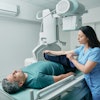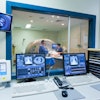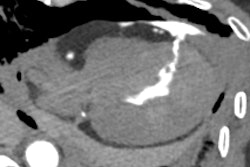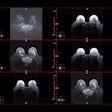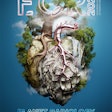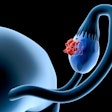A German forensic radiologist has scooped a top ECR award for developing a postmortem CT technique for the unambiguous identification of corpses.
Dr. Andreas Heinrich, from the department of radiology at Jena University Hospital - Friedrich Schiller University in Jena, explained that his method involves extracting computer vision features from images, such as orthopantomograms (OPGs), and storing them in a database. He was the sole author of one of nine e-posters that received a magna cum laude award on the opening day of the congress.
“Computer vision features are distinctive visual attributes or characteristics extracted from images, enabling computers to analyze and understand visual information. The computer can recognize comparable features,” he noted. “If there is a high degree of similarity in computer vision features between the postmortem image and the antemortem reference image, the unknown deceased individual has been identified with a high probability.”
The acquisition of postmortem OPGs is very challenging, he continued. CT is preferred for postmortem imaging, but research has failed to determine the extent to which head CT images of facilitate unequivocal identification.
Heinrich analyzed 819 cranial CT (CCT) exams of 722 people (age range 10 to 99; 321 female, 452 male, and 46 unknown) acquired between November 2016 and May 2023. He defined six regions, for which CT slices were manually selected from the CT series: lower row of teeth, upper row of teeth, end of maxilla, cervical spine, maximal representation of maxillary sinus, and maximal representation of eye structures OPGs.
Large metal artifacts, such as those caused by dental implants, or other artifacts led to the inability to definitively locate all the required categories, he stated. Consequently, these specific images could not be exported from the CT series for the subsequent identification process. For comparative analysis, he included an additional 1,771 OPGs acquired from the same individuals between December 2000 and May 2023.
For unique person identification, between 50 and 69 CT slices per region (the most recent ones from individuals with at least two exams) were compared with up to 818 database entries. Additionally, 410 OPGs were matched with 1,759 OPGs from the same individuals.
Identification using CT images was achievable for approximately 72% to 87% (rank 1-10) of the individuals. In all CT regions, same-individual identification achieved a score of 12.04 ± 0.86%, while different individuals scored 2.15 ± 0.4%. This resulted in successful identification rates of 60 ± 8% (rank 1), 70 ± 8% (rank 5), and 74 ± 9% (rank 10). The maxillary sinus (region E) exhibited the highest success rates at 72% (rank 1), 80% (rank 5), and 87% (rank 10). Using OPGs as a reference yielded success rates of 86% (rank 1), 87% (rank 5), and 88% (rank 10).
The higher scores for different individuals in CT slices -- five to nine times higher than in OPGs -- may be attributed to factors such as metal artifacts, lower image resolution, and similar objects. Even for images taken several years apart, successful identification was achieved, according to Heinrich.
“In future research, CT examinations of the thorax and abdomen will be explored, as these areas may offer additional distinctive computer vision features, thereby enhancing the success rate of computer vision-based human identification using CT images,” he concluded.
The other eight magna cum laude recipients at ECR 2024 are:
- Reading normal pediatric chest x-ray made easy. I.A. Alhashimi, S.M. Elmistiri, A.F. Huneity, S.B.M. Zoghoul, A. Sadiq, S. Samaan; Doha, Qatar.
- The broad imaging spectrum of adenomyosis: Beyond the junctional zone thickening. B. Ergin, D. Sungur, O. Şahin, E. Aydin, H. Şahin; Izmir, Turkey.
- A future to remember: Deep-learning applications in neuroimaging prediction and diagnosis of Alzheimer’s disease. A. Fulga, A. C. Ciurescu, M. Calinescu, B. Popa; Bucharest, Romania.
- Interpreting the Videofluoroscopic Swallow Study (VFSS): The gold standard for evaluating dysphagia. J. Janwar, H.L. Soh, F.A-Z. Haji Johan, S.S. Chok, H.W. Khoo, A.Y.Q. Soon, A. Karandikar, J. Goh; Singapore.
- Photon counting CT - A leap forward in medical imaging. J. Lydia, F. Abubacker Sulaiman, R. Praveenkumar; Chennai, India.
- Strategies in extrahepatic hepatic artery pseudoaneurysms (eHAPAs) endovascular treatment. F. Labella, M.G. Riga, S. Groff, G. Barbiero, M. Battistel, G. De Conti; Padova, Italy.
- Main findings and complications after the placement of CSF shunts: the keys to a brilliant radiological diagnosis. A.S. Gabín, S. Revuelta Gómez, A. Somoano, et al; Santander, Spain.
- Thoracic involvement in diseases related to dysregulated humoral immunity. J.G. Maluf, J.F. Maluf, T.R. Yamanari, H. Lee, T. Lima, D. Cardoso, V.D. Bichuette, R.V. Auad, M.V.Y. Sawamura; Sao Paulo, Brazil.
For more coverage from ECR 2024, please visit our RADCast.
